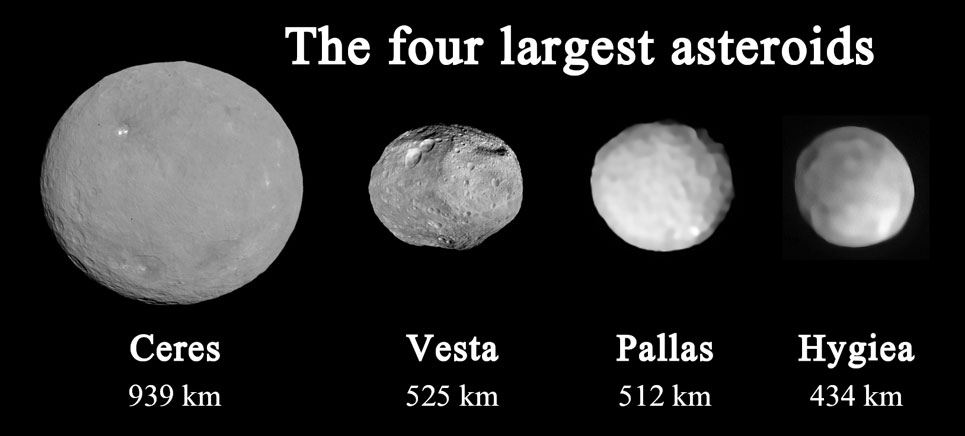Asteroids are celestial objects that orbit around the Sun just like planets. However, asteroids are much smaller than the planets. The relatively smaller asteroids are called minor planets and bigger ones are called planetoids. The size of asteroids greatly varies. The largest asteroid, Ceres, is 939 km (almost 600 mi) wide and is big enough to be classified as a dwarf planet like Pluto.
What Asteroids are Made of?
Asteroids are the rocky objects. Ceres is made of a rocky core covered by an icy mantle. Vesta, another major asteroid, is has a nickel-iron core, olivine mantle, and basaltic crust. Traces of amino acids and other organic compounds have been found in asteroids. This gives rise to a thought that asteroid impacts on the Earth were responsible for bringing the organic compounds necessary for the creation of life.
How were the Asteroids Formed?
Asteroids are thought to be the remnants from the process of formation of the solar system. The pieces of matter that could not become part of the Sun, the planets and the satellites, became asteroids. Our solar system came into existence about 4.6 billion years ago. So, the asteroids were formed really long ago!
Biggest Asteroids
Ceres, Vesta, Pallas and Hygiea are the four largest asteroids in our solar system. All these asteroids are located in the main asteroid belt. Ceres is 939 km wide, Vesta is 525 km wide, Pallas is 512 km and Hygiea is 434 km wide. Of these, the Ceres is massive enough to be a dwarf planet. It’s mass is enough to have become rounded because of its own gravity. Ceres is the only dwarf planet within the orbit of Neptune.

Asteroid Belt
Asteroid belt is a region in the solar system where millions of asteroids are located. This region lies between the orbits of Mars and Jupiter. According to an estimate the asteroid belt contains 1.1 to 1.9 million big asteroids (i.e. larger than 1 kilometer in diameter). In addition, there are millions of smaller asteroids too.
Who Discovered First Asteroid?
Ceres was the first asteroid to be discovered. An Italian astronomer Giuseppe Piazzi discovered Ceres on 01 January 1801. Ceres was named after the Roman goddess of agriculture.
ALSO SEE: Difference between asteroids and comets
Can Asteroids Hit the Earth?
In theory, yes, asteroids can hit the Earth. But in reality the chances of an asteroid hitting the Earth are very small. Earth’s atmosphere easily burns small space objects falling through it. In order to cause widespread damage on Earth, an asteroid has to be at least one kilometer in size. According to NASA, such an asteroid might hit the earth once in 100,000 years. Chances of earth being hit by other objects, like comets, of similar size are even slimmer — once in 500,000 years.
Celestial objects with larger size, like 5 km (3 mi), hit the Earth, on average, every twenty million years. The last known impact of an object of 10 km (6 mi) or more in diameter was 66 million years ago — when dinosaurs went extinct.
Note: No human being in the past 1000 years is known to have been killed by a meteorite or by the effects of one impacting.
Can We Stop Asteroids from Hitting the Earth?
Yes. Now various nations keep watch on the space and any celestial object on path to the Earth would be detected much in advanced. It is not like an asteroid or comet can surprise us by suddenly appearing very near to the Earth. World’s nations will have plenty of time to make a collective plan and take measures to destroy or deflect any approaching object.
Asteroids would only need a slight push to deflect away from the earth. Such a push can be given using rockets or explosions.
Location of the Asteroid that Killed Dinosaurs
The Chicxulub crater, in the state of Yucatán in Mexico, is the location where an asteroid of 11 – 81 km (6.8 to 50.3 miles) size struck about 66 million years ago. The hit by Chicxulub impactor caused widespread loss of life on Earth, including the extinction of dinosaurs.
The crater is estimated to be 150 kilometers (93 miles) in diameter and 20 kilometers (12 miles) in depth.
Use the citation below to add this article to your bibliography
"Asteroids: Definition and What Asteroids are Made of?." Dashamlav.com. Web. 27 July 2024. <https://dashamlav.com/asteroid-definition-made-of-largest-hit-location-dinosaurs/>
Dashamlav.com, "Asteroids: Definition and What Asteroids are Made of?." Accessed 27 July 2024. https://dashamlav.com/asteroid-definition-made-of-largest-hit-location-dinosaurs/
"Asteroids: Definition and What Asteroids are Made of?." (n.d.). Dashamlav.com. Retrieved 27 July 2024 from https://dashamlav.com/asteroid-definition-made-of-largest-hit-location-dinosaurs/
